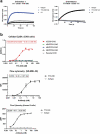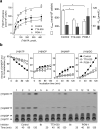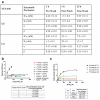Fully human anti-CD39 antibody potently inhibits ATPase activity in cancer cells via uncompetitive allosteric mechanism
- PMID: 33146056
- PMCID: PMC7646477
- DOI: 10.1080/19420862.2020.1838036
Fully human anti-CD39 antibody potently inhibits ATPase activity in cancer cells via uncompetitive allosteric mechanism
Abstract
The extracellular ATP/adenosine axis in the tumor microenvironment (TME) has emerged as an important immune-regulatory pathway. Nucleoside triphosphate diphosphohydrolase-1 (NTPDase1), otherwise known as CD39, is highly expressed in the TME, both on infiltrating immune cells and tumor cells across a broad set of cancer indications. CD39 processes pro-inflammatory extracellular ATP to ADP and AMP, which is then processed by Ecto-5'-nucleotidase/CD73 to immunosuppressive adenosine. Directly inhibiting the enzymatic function of CD39 via an antibody has the potential to unleash an immune-mediated anti-tumor response via two mechanisms: 1) increasing the availability of immunostimulatory extracellular ATP released by damaged and/or dying cells, and 2) reducing the generation and accumulation of suppressive adenosine within the TME. Tizona Therapeutics has engineered a novel first-in-class fully human anti-CD39 antibody, TTX-030, that directly inhibits CD39 ATPase enzymatic function with sub-nanomolar potency. Further characterization of the mechanism of inhibition by TTX-030 using CD39+ human melanoma cell line SK-MEL-28 revealed an uncompetitive allosteric mechanism (α < 1). The uncompetitive mechanism of action enables TTX-030 to inhibit CD39 at the elevated ATP concentrations reported in the TME. Maximal inhibition of cellular CD39 ATPase velocity was 85%, which compares favorably to results reported for antibody inhibitors to other enzyme targets. The allosteric mechanism of TTX-030 was confirmed via mapping the epitope to a region of CD39 distant from its active site, which suggests possible models for how potent inhibition is achieved. In summary, TTX-030 is a potent allosteric inhibitor of CD39 ATPase activity that is currently being evaluated in clinical trials for cancer therapy.
Keywords: ATP; CD39; allosteric regulation; cancer; cancer therapy; enzyme inhibitor; enzyme kinetics; enzyme mechanism; monoclonal antibody.
Conflict of interest statement
Spatola, BN, Lerner, AG, Wong, C, dela Cruz, T, Welch, M, Fung, W, Kovalenko, M, Beers, C, Corbin, J, and Soros, VB are, or were, employees of Tizona Therapeutics and hold stock and/or stock options in the same. Research by Losenkova, K and Yegutkin, GG was in part sponsored by Tizona Therapeutics.
Figures






Similar articles
-
Inhibition of CD39 enzymatic function at the surface of tumor cells alleviates their immunosuppressive activity.Cancer Immunol Res. 2015 Mar;3(3):254-65. doi: 10.1158/2326-6066.CIR-14-0018. Epub 2014 Nov 17. Cancer Immunol Res. 2015. PMID: 25403716
-
2-Substituted thienotetrahydropyridine derivatives: Allosteric ectonucleotidase inhibitors.Arch Pharm (Weinheim). 2021 Dec;354(12):e2100300. doi: 10.1002/ardp.202100300. Epub 2021 Oct 26. Arch Pharm (Weinheim). 2021. PMID: 34697820
-
SRF617 Is a Potent Inhibitor of CD39 with Immunomodulatory and Antitumor Properties.Immunohorizons. 2023 May 1;7(5):366-379. doi: 10.4049/immunohorizons.2200089. Immunohorizons. 2023. PMID: 37219538 Free PMC article.
-
The role of the CD39-CD73-adenosine pathway in liver disease.J Cell Physiol. 2021 Feb;236(2):851-862. doi: 10.1002/jcp.29932. Epub 2020 Jul 10. J Cell Physiol. 2021. PMID: 32648591 Review.
-
Review immune response of targeting CD39 in cancer.Biomark Res. 2023 Jun 7;11(1):63. doi: 10.1186/s40364-023-00500-w. Biomark Res. 2023. PMID: 37287049 Free PMC article. Review.
Cited by
-
Characterization of AB598, a CD39 Enzymatic Inhibitory Antibody for the Treatment of Solid Tumors.Mol Cancer Ther. 2024 Oct 1;23(10):1471-1482. doi: 10.1158/1535-7163.MCT-23-0865. Mol Cancer Ther. 2024. PMID: 38797955 Free PMC article.
-
ATP and Adenosine Metabolism in Cancer: Exploitation for Therapeutic Gain.Pharmacol Rev. 2022 Jul;74(3):797-822. doi: 10.1124/pharmrev.121.000528. Pharmacol Rev. 2022. PMID: 35738682 Free PMC article. Review.
-
Immune checkpoint modulators in cancer immunotherapy: recent advances and emerging concepts.J Hematol Oncol. 2022 Aug 17;15(1):111. doi: 10.1186/s13045-022-01325-0. J Hematol Oncol. 2022. PMID: 35978433 Free PMC article. Review.
-
Hypoxic link between cancer cells and the immune system: The role of adenosine and lactate.Oncol Res. 2025 Jul 18;33(8):1803-1818. doi: 10.32604/or.2025.065953. eCollection 2025. Oncol Res. 2025. PMID: 40746883 Free PMC article. Review.
-
Tumor intrinsic and extrinsic functions of CD73 and the adenosine pathway in lung cancer.Front Immunol. 2023 Mar 24;14:1130358. doi: 10.3389/fimmu.2023.1130358. eCollection 2023. Front Immunol. 2023. PMID: 37033953 Free PMC article. Review.
References
MeSH terms
Substances
LinkOut - more resources
Full Text Sources
Other Literature Sources
Research Materials
